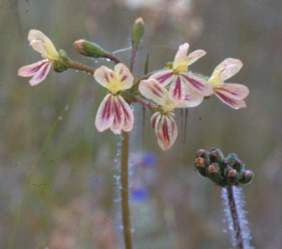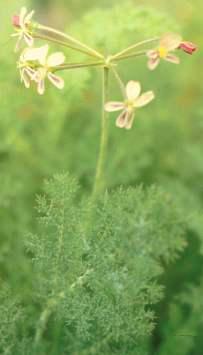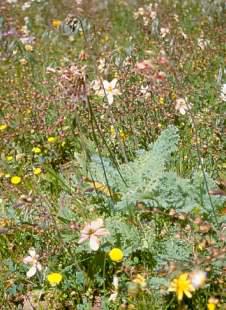Pelargonium triste
Pelargonium triste (L.) L'Hér.
Family: Geraniaceae
Common names: night-scented pelargonium ( Eng. ); kaneeltjie, rooiwortel (Afr.); wit n/eitjie (Khoi)
Introduction
This night-scented pelargonium, with its attractive carrot-like leaves, makes an interesting addition to collections of Cape plants.

Description
Description
Pelargonium triste is a geophytic species that has a large, subterranean tuber with tuberous roots with a rather cracked, woody bark. The prostrate leaves are produced directly from ground level with minimal stem growth; they are hairy, divided, and softly feathered, resembling the leaves of a carrot plant.

The sturdy inflorescence is carried well above the leaves. The leaves on the flowering stems are usually much smaller than those on the main stem. The inconspicuous pale yellow flowers are star-shaped with dark maroon to black markings and are scented at night. Plants flower from August to February.
Distribution and habitat
Distribution description
Pelargonium triste occurs from Steinkopf in Northern Cape to Albertinia in the southern part of Western Cape. Plants usually occur on sandy flats and slopes.

Derivation of name and historical aspects
History
The genus Pelargonium belongs to the family Geraniaceae, a large family of 11 genera and 800 species in the tropical and subtropical regions of the world. There are 270 species of Pelargonium which occur in south, east, and north-east Africa, in Asia, St Helena, Tristan da Cunha, Madagascar, Australia and New Zealand. In southern Africa 219 species occur.
The genus Pelargonium derives its name from the resemblance of the shape of the fruit to the beak of a stork, pelargos in Greek. The species name triste (Latin), meaning dull coloured, refers to the dull colour of the flowers. The common name, night-scented pelargonium, refers to the strong clove scent the flowers emit at night.
A famous plant collector, John Tradescant, took Pelargonium triste to England in 1632, one of the first pelargoniums from the Cape to be collected and cultivated.
Ecology
Ecology
The plant, with its strong clove scent, suggests that it is pollinated by long-tongued pollinators such as moths which are active during the night. The plants survive the dry season by going dormant. Fresh leaves emerge from the tubers when it rains again.
Uses
Use
Pelargonium triste has tannin-rich tubers, which are used in Namaqualand for tanning leather a rich, reddish brown colour. Infusions from the tubers are used for treating dysentery and diarrhoea.
Growing Pelargonium triste
Grow
Pelargonium triste can be grown from cuttings, seed and from dividing clumps of the tubers. Cuttings can be made in autumn or spring. Short stem cuttings can be taken and dipped into rooting hormone to promote the formation of roots. The cuttings are placed in a propagation medium made up of coarse river sand. They are then kept in a cold frame until rooting has taken place. Once rooted, plants are potted into a well-drained, composted mixture for further growth.
Seeds can be sown in late summer in a well-drained soil mixture. Germination usually takes place after three weeks. The seedlings should also be potted in a well-drained, composted soil mixture.
Tubers can be divided when the plant is not in its active growing stage.
These plants are best grown in containers, unless one has a very well drained site with sandy soils. It is best to withhold water during their dormant period, but in the Kirstenbosch pelargonium collection the plants are watered in summer and retain their leaves throughout the year. They are grown in pots with excellent drainage.
References
- Bean, A. & Johns, A. 2005. Stellenbosch to Hermanus. South African Wild Flower Guide 5. Botanical Society of South Africa , Cape Town .
- Van der Walt, J.J.A. 1997. Pelargoniums of southern Africa . Purnell, Cape Town .
- Van Wyk, B-E. & Gericke, N. 2000. People's plants. A guide to useful plants of southern Africa . Briza Publications, Pretoria .
- Van Wyk, B-E., Van Oudtshoorn, B. & Gericke, N. 1997. Medicinal plants of South Africa . Briza Publications, Pretoria.
Credits
Trevor Adams
Kirstenbosch NBG
February 2006
Plant Attributes:
Plant Type: Bulb, Perennial
SA Distribution: Northern Cape, Western Cape
Soil type: Sandy
Flowering season: Spring, Early Summer
PH: Neutral
Flower colour: Yellow, Mauve/Lilac
Aspect: Full Sun
Gardening skill: Easy
Special Features:
Horticultural zones








Rate this article
Article well written and informative
Rate this plant
Is this an interesting plant?
Login to add your Comment
Back to topNot registered yet? Click here to register.